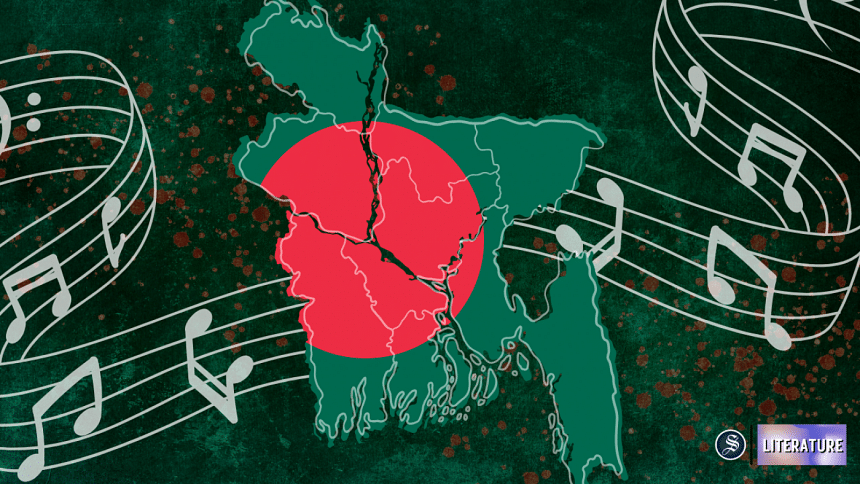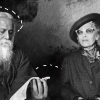On the national anthem of Bangladesh: An apologetic discourse (part two)

The recent attack on "Amar Shonar Bangla" stems from a type of attempt to categorise the national anthem, leading to further allegations against it. In this discussion, we discuss how Rabindranath Tagore's ability to transcend the physical border of nation and abstract border of religion makes his song fitting for the culturally diverse Bangladesh, rendering all propagandas or attempts of attack impotent.
National anthem written by a poet of another nation: From India to Bangladesh
The matter of sentimentality as the essence of the national anthem resurfaces when Tagore's nationality is questioned. For many, the issue is how can a non-Bangladeshi write the national anthem of Bangladesh?
Again, as Bangladesh did not exist in Tagore's lifetime, he wouldn't be a Bangladeshi even if he wanted to. But Tagore embodies the sentiment of Bangladesh in "Amar shonar Bangla" and the song itself does not have any dimension that does not go with the values, morals, and ethics our region fosters.
But the question here should be: Why does the nationality of the poet matter if the sentiment and emotional dimensions are the central focus that keeps the dynamic of a national anthem active? Kazi Nazrul Islam was born in India but this didn't stop him from being the national poet of Bangladesh. He was later attributed with the nationality officially but originally, he was an Indian. This basically shows that it is the sentiment, the essence, the internal component of an art or literary piece that matters rather than the material aspect of it. As a matter of fact, a significant number of national anthems were written before the inception or conception of the nation. It means the composer was not initially the citizen of the nation in the first place. Thus, nationality is irrelevant in such scenarios.
Tagore's treatment of religion: A Hindu extremist or an appreciator of Islam?
Though not entirely related to the national anthem, a point of attacking Tagore and reasoning for why his song should not be our national anthem is the argument that he was a Hindu extremist and held bias against Muslims. The argument goes in two ways here.
Firstly, by arguing Tagore is Hindu extremist, it is argued that his song too has Hindu sentiments. The "Maa" in "Amar Shonar Bangla" is often misinterpreted as referring to Debi Durga. Such intentional misinterpretation leads to the argument that such extremism cannot be part of a majority Muslim nation.
Secondly, by deducing that Tagore had religious bias, a group tries to argue that a culturally and religiously diverse country should not have a national anthem written by someone who has hints of religious partiality.
But navigating through Tagore works reveals a completely different picture. In fact, if you take a survey, you are likely to find that Nazrul wrote more on the deities of the Hindu religion compared to Tagore. Moreover, Tagore has Islamic influences in his works although it's not widely talked about.
It's undeniable that Tagore was a monotheistic Brahman and this Brahman origin is the reason many assume him to be a Hindu extremist. However, despite being a Hindu, Tagore wrote extensively on all religions including Buddhism, Christianity, Shikh, and Islam. He even criticised the sectarian structure of the mainstream Hindu religion. Mohammad A. Quayum, in his paper "Rabindranath Tagore: A Sectarian or a Cosmopolitan Writer?" argues that Tagore was against sectarian religious structure. One such criticism of sectarianism by Tagore can be found in Fireflies, where he wrote, "The Sectarian thinks that he has the sea ladled into his private pond."
Quayum's paper also talks about Tagore's criticism of Hindu hypocrisy, of formalistic rigidity of Hinduism, and the critique of Brahminism seen in many of his stories like "Durasha" despite being a Brahman himself. And yet, some critics still accuse Tagore of Hindu chauvinism. What is even more, he is also criticised for having antipathy towards the Muslim.
Tagore's work has a very visible presence of Islam and Muslim culture overall. For example, Tagore wrote "Kon Alote Praner Prodip", celebrating the birth of Prophet Muhammad. He wrote, "Among all the religions of the world, Islam is a notable one. This factor attributes the followers of Islam with certain responsibilities". Read originally by Sorojoni Naidu on "Paygambar Dibash" in 1933, this very speech was later broadcasted on the radio in 1934 celebrating Prophet Muhammad's birthday. It further read, "On this blissful occasion, I express my gratitude toward this great saint of Islam along with my Muslim brothers…" and ends with anticipating blessings on the Indian subcontinent. This kind of approach and treatment of Islam shows his respectful perception of the religion, which is definitely anything but anti-Islamic.
His appreciation does not stop here. On February 27, 1936, Tagore wrote in the "Paygambar" edition of The Peshwa magazine, "I take this opportunity to offer my veneration to the Holy Prophet Mohammad, one of the greatest personalities born in the world." In this essay, he further pays his respect to Prophet Muhammad for bringing a novel purity in the world. He expresses his perception of the religion to be sublime in its teaching, a quality that he believed can help to maintain peace and solidarity in the culturally diverse nation of India.
Tagore further expressed his connection with the Islamic culture in a 1930 lecture at Oxford University where he confessed that his sensibility was shaped by "a confluence of three cultures, Hindu, Mohammedan, and British."
Tagore's fascination with Islamic culture is most apparent in his appreciation of Sufism. He wore cloaks instead of traditional Brahman dress, and was surrounded by Muslim food and Persianate ambience thanks to his father. This gives an impression of his passion for Sufi culture. Not only Tagore himself, but the entire Tagore family was greatly influenced by the Persian poet Hafiz. His father, Debendranath Tagore was proficient in Persian and is said to have memorised the entirety of The Divān of Hafez.
The intensity of his profound passion for Hafiz becomes transparent from his Parashya Yatri. In the year of 1932, at the age of 71, Tagore visited Shiraz for an entire week to pay his respect to Saadi and Hafiz. He arrived at the tomb of Hafiz to sit there silently for a while. Iranian poets Muktaderi and Jiauddin Baranir wrote similar accounts of that visit. They both wrote in their own way that while Tagore sat there, a Gazal of Hafiz was sung. Listening to that Gazal, Tagore unbridled his emotions and drenched his silver beard with the flow of pure tears. In Parasya Yatri, Tagore wrote about this minute experience saying "My entire writing career is on one side while this fleeting moment of poetic essence is on the other. There is something spiritual within this land that has charmed my heart and soul." Such love and devotion for Hafiz should tell you all about his perception of Islam and Muslim individuals.
Many of his short stories, including the most popular "Kabuliwala", "Musolmanir Golpo", and "Samassya Puran", have representations of Muslim individuals, all of which are shown as calm and comforting figures with a particular type of immanence. The Muslim characters in his stories are empathetic beings and are treated with utmost respect.
In contrast, Bankim Chandra Chatterjee's perception of Muslims is very apparent in his novel Anandamath. Tagore stands on the completely opposite side of Bankim in this regard. Tagore's stance on the issue of religious extremism is reflected in Akbar Ali Khan's Durbhana O Vabna Rabindranathke Niye where Khan discusses an interaction between Bankim and Tagore. In 1896, Bankim asked Tagore to compose the melody of Bankim's song "Bandemataram". Though Tagore did work on the first two stanzas, he refused to compose the next bit simply because in that part Bankim worships the nation as Debi Durga. In other words, Tagore did not appreciate the idea of conceptualising the country as the Goddess Durga. Tagore explained his monotheistic position to Bankim in the following way,
"To me, the spirit of tenderness and devotion expressed in its first portion and the emphasis it gave to the beautiful and beneficent aspects of our Motherland made a special appeal, so much so that I found no difficulty in dissociating it from the rest of the poem and from those portions of the book of which it is part, with all the sentiments of which, brought up as I was in this monotheistic ideals of my father, I could have no sympathy."
This should answer the allegations that claim that the "Maa" in "Amar Shonar Bangla" is Debi Durga. As he refused to address the country as such in Bankim's song, it's absurd to assume that he would incorporate such an idea in his own work. Besides, the Parjaay or classification of "Amar Sonar Bangla" is 'Swadesh' or patriotic and not 'Puja' or offerings. Thus, the claim of "Amar Sonar Bangla" having any religious reference doesn't really add up.
Some more quick facts can elucidate further Tagore's perception of Islam. For starters, Tagore established an Islamic Studies Department at the Visva-Bharati University in 1927. The many Muslims he admitted in Visva-Bharati University includes Syed Mujtaba Ali right after the establishment of the university.
His relationship with Muslim writers also show how he accommodated people in his life without considering their religion or identity, but simply for their essence and internal illumination. From Muhammad Shahidullah, Kazi Nazrul Islam, Kazi Abdul Wadud, Shahid Suhrawardy to Bande Ali Miyan, he had close relations with many of his contemporary Muslim authors who reciprocated his welcoming attitude regardless of religion.
Tagore's overall attitude, his lifestyle, likings, and perception of life earned him the title "Muslim" at heart. Poet Golam Mostafa is known to have said, "We did not find any hostility towards Islam in the vast literature produced by Tagore. On the contrary, there is so much of Islamic content and ideals in his writings that he can be called a Muslim without hesitation". Dutta and Robinson, in the book Rabindranath Tagore: The Myriad-minded Man, records a letter Tagore wrote in 1931 where he said, "As far as the country itself is concerned... we cannot deny the fact that the Mussulmans are our close relations... I love [my Mussulman tenants] from my heart because they deserve it".
As it shows, Tagore in reality was completely opposite of being a Hindu extremist and anti-Islam. Rather, he criticised the Hindu social system while praising the teaching, preaching, and inclusivity of Islamic approach. He particularly appreciated the fact that, unlike Hinduism, Islam does not have any hierarchical caste system. So how does one hold on to the belief that Tagore hated or held hateful views toward Islam? By clinging on to anti-Tagore propaganda and rumours of course.
The magnificence of "Amar Shonar Bangla"
As I argue in this two-part discourse, while the allegations against our national anthem are weak, "Amar shonar Bangla" is strong in its own merit.
While many national anthems like "La Marseillaise", the national anthem of France, are about war, resistance, and violence, Tagore's song is devoid of any violent sentiment. It's mostly about solidarity of a culturally diverse population and an appreciation of the motherland. The expression of solidarity is not homogenising yet perfectly relatable to all. Though not a part of the national anthem, the original "Amar Sonar Bangla" reads in the fifth stanza, "Oh mother mine, all the brothers of mine are shepherds and farmers at your service". It expresses the mutual belongingness within the land of Bengal. This is one of the factors that enables "Amar Shonar Bangla" to be widely and mutually accepted and relevant for Bangladesh.
Of course, Tagore talks about solidarity in reference to shepherds and farmers because agriculture is the soul of this region. Tagore hums a hymn for this fertility of the land saying,
"In Spring, Oh mother mine, the fragrance from
Your mango groves make me wild with joy–
Ah, what a thrill!"
In the following part Tagore further words the glorification of Bengals economic-enlivening fertility in the following way,
"In Autumn, Oh mother mine,
in the full-blossomed paddy fields,
I have seen spread all over–sweet smiles!"
Along with the notion of solidarity, fertility, and prosperity, Tagore incorporates the peaceful landscape of Bengal in the lyrics as it is a treasure itself. His lines,
"Ah, what a beauty, what shades, what an affection
and what a tenderness!
What a quilt have you spread at the feet of
banyan trees and along the banks of rivers!"
paint a vivid picture of the comfortable tranquillity the nature of Bengal continuously nurtures us in. This amalgamation of peace, brotherhood, and fertility highlights the core essence of Bengal and of Bangladesh that makes our home an abode we cannot locate in any other place of the world. As Tagore explored more or less the entirety of Bengal while treading almost half of the world, he knew where the essence, the value of Bengal region lay, and that's what he infused within his song.
Keeping in mind this intimate connection between us and our motherland, the national anthem ends with the empathetic tone,
"If sadness, Oh mother mine, casts a gloom on your face,
my eyes are filled with tears!"
Such personification makes the motherland less of a country marked by materialistic features of land or borders and more of a "mother" itself that makes us comfortable within its multi-seasonal embrace.
Propaganda and misinformation have always been active in its attempt to mislead us. But no matter what happens, the love, appreciation, passion, and respect "Amar Shonar Bangla" inspires is incomparable; it is a way for us to reach deeper within our sentimentality and connect with the country we love so dearly.
The author owes special thanks to Niloy Arya, Arif Rahman, Mohammad Quayum, and his friend, Shahreen Khan Taan.
This is the second part of a two-part series, serialised here on Star Literature.
Abdullah Rayhan is studying English Literature at Jahangirnagar University.

 For all latest news, follow The Daily Star's Google News channel.
For all latest news, follow The Daily Star's Google News channel. 











Comments